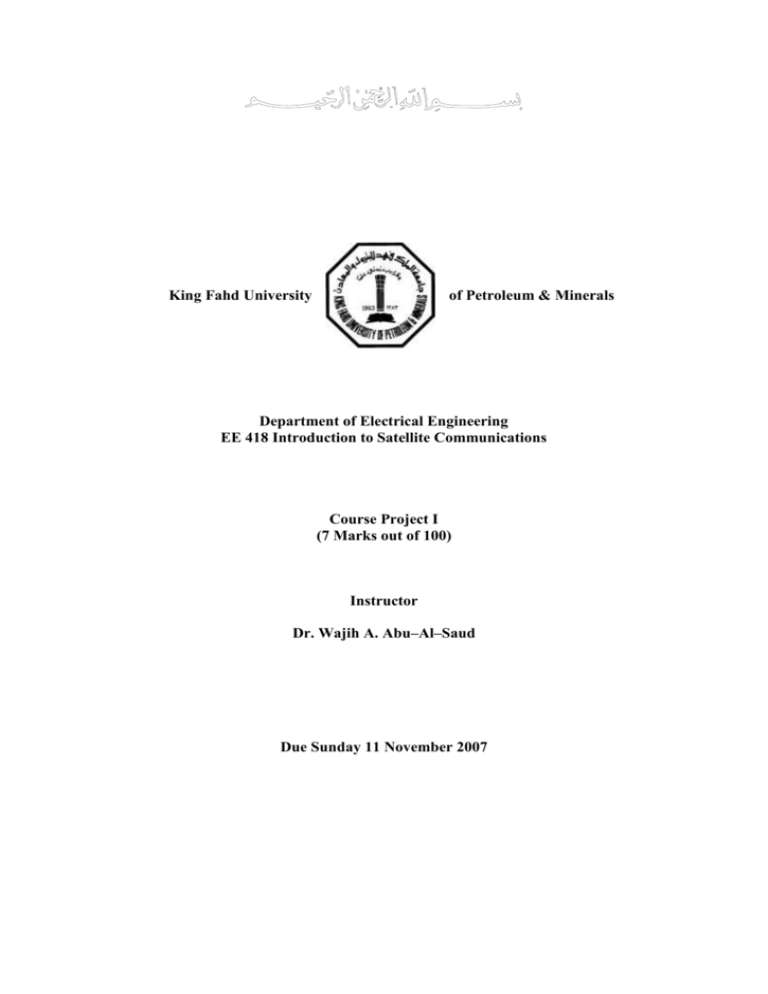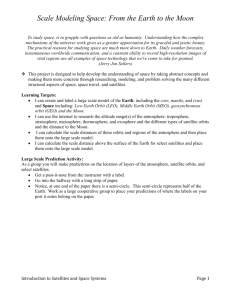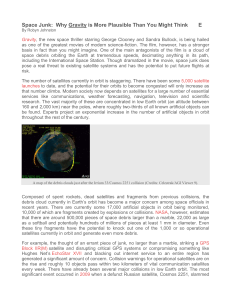Project 1
advertisement

King Fahd University of Petroleum & Minerals Department of Electrical Engineering EE 418 Introduction to Satellite Communications Course Project I (7 Marks out of 100) Instructor Dr. Wajih A. Abu–Al–Saud Due Sunday 11 November 2007 Introduction One of the several tasks that a satellite engineer performs when designing a network of satellites is determining the orbit of each satellite in this network. The choice of orbits is generally based on the application that the satellite is launched to serve or on the customers who will benefit from the satellite. Determining the orbit of a satellite means determining its altitude (or radius) for circular orbits or the apogee–perigee points for elliptical orbits, the inclination angle, intersection points of the orbit (if it is inclined) with the equatorial plane, and phase of rotation of the satellite in its orbit (these parameters are explained later). Sometimes, satellites are launched to provide near full–Earth coverage. Such coverage can be provided by three GEO satellites spaced 120 apart. Clearly such a configuration provides coverage to most of Earth surface but does not provide coverage to the two polar regions. To provide coverage to the two polar regions, three more (not two) satellites in addition to the three GEO satellites are needed making a total of 6 satellites. In fact, if using three GEO satellites orbiting Earth in the Equatorial plane is not necessary, full coverage of ALL Earth surface (100% of Earth surface, 24 hours a day, 365 days a year) can be achieved using only 5 satellites instead of 6. The purpose of this project is to study the effect of orbital parameters on Earth coverage for different number of satellites. In each case, you are asked to choose parameters of satellite orbits that will provide full Earth coverage using a particular number of satellites with specific requirements. To study the coverage of satellites to Earth surface, consider the following points: o Since some or all of the satellites in each study case we consider will not be GEO satellites, some or all customers will have to track the satellite that is visible to them and will have to switch from one satellite to another at different points during the orbital period of the satellites. However, this is not our concern here. o Signals from satellites that have very low elevation angles cannot be used properly. Therefore, we will consider that a satellite is visible from Earth to the region on Earth's surface that sees the satellite with an elevation angle of 5 or higher. o At any time and from any point on Earth's surface, at least one satellite with the minimum elevation angle must be visible to have full Earth coverage. Visibility of more than one satellite at some point on Earth's surface is not useful as the user will be receiving from one satellite only. In fact, having more than one satellite visible for extended period of time at some point on Earth indicates that the distribution of satellites around Earth is inefficient and therefore full coverage may not be achieved. o Since we are interested in full Earth coverage, it is easier to study full Earth coverage assuming Earth does not revolve around itself. Once we obtain full Earth coverage for a stationary Earth, this clearly means that full Earth coverage will be automatically obtained for a revolving Earth except that different satellites will be providing the coverage to a particular point on earth in this case compared to the previous case. o The orbits of satellites that we will consider in this project are all circular (not elliptical) orbits. This will simplify the project significantly. Matlab Program Since writing a program that will determine the converge of a set of satellites is beyond the scope of this project, you are provided with a fully functioning Matlab program that will do this task. All you have to provide it with a set of parameters to determine the satellite coverage. Elevation angles are computed by the provided program for the whole surface of Earth (180 W to 180 E in steps of 2, and 90 S to 90 N in steps of 2). The computation of minimum elevation angles is performed as satellites move in their orbits (0 to 360 in steps of 2). Therefore, each step of the program computes the elevation angles for the whole Earth's surface for a particular phase angle of the satellite orbit. If you open the Matlab program "Project1.m", you will see the part of the Matlab code in which you input orbit parameters starting from line 17. These parameters are described as follows: RS: This is the common radius (not altitude) of all satellites. Use RS = GEO to state that the radius is that of a GEO satellite. You can also use radius of the form of 0.7*GEO or any radius in (km) to specify the common satellite radius. Since all satellites have the same circular orbit radius, they will have the same period. So, computation of the minimum elevation angle for one period of all satellites is sufficient regardless of the length of that period. If different satellite radii are used, you may have to study the coverage of satellites over a very long period of time, which may be extremely difficult. No_Sat: This represents the number of satellites in your configuration. MinEL: Minimum elevation angle in Degrees. We will set this parameter to a constant of 5 for the whole project. Now, for each satellite, we have three angles along with the radius above that will specify the exact orbit of a circular satellite. You will have to specify these angles for all satellites in your configuration (satellites will be numbered 1, 2, 3, …, No_Sat). Ignore parameters for satellites with numbers above No_Sat. The three angles are Inc: This angle specifies the inclination angle of the orbit from the Equatorial orbit. Inc = 0 means the satellite has an Equatorial orbit Inc = 90 means the satellite has a Polar orbit 0 < Inc < 90 means the satellite has an inclined orbit other than the inclinations above. The following figure illustrates the orbits of 5 satellites with different inclination angles of –20 (dark blue), 0 (green. This is an Equatorial orbit), 20 (red), 40 (light blue), and 90 (purple). The figure below is generated by the program when you run it with the above parameters. Phi: This angle determines the two points at which the inclined orbit of a satellite will intersect the equatorial plane. Changing this angle does not affect an Equatorial orbit. However, for an inclined this angle will rotate the orbit around the North–South axis of Earth. Phi = 0 means the satellite will cross the Equatorial plane at the points 0 and 180 Longitude angles. Phi = 90 means the satellite will cross the Equatorial plane at the points 90 E and 90 W Longitude angles. Phi = 20 means the satellite will cross the Equatorial plane at the points 20 E and 160 W Longitude angles, and so on. The following figure illustrates the orbits of 5 satellites with the same inclination angle of 30 but 5 different Phi angles of 0 (dark blue), 20 (green), 40 (red), 60 (light blue), and 80 (purple). The following figure illustrates the orbits of 5 satellites with the same inclination angle of 90 but 5 different Phi angles of 0 (dark blue), 20 (green), 40 (red), 60 (light blue), and 80 (purple). Theta: This angle determines the phase of the satellite in the particular orbit specified by RS, Inc, and Phi. Specifying values for RS, Inc, and Phi determines a circuit orbit around Earth as . In this orbit, we can put theoretically an infinite number of satellites at different points. Theta specifies the location of the satellite in this orbit. Satellites with the same RS, Phi, and Inc but different Theta angles follow each other in the same orbit. For example: Theta = 0 means the satellite starts its orbital period from the Equatorial plane. Theta = 90 means the satellite starts its orbital period from one of its furthest points from the Equatorial plane. Theta = 180 means the satellite starts its orbital period from the other point on the Equatorial plane. The following figure illustrates the orbits of 5 satellites with the same inclination angle of 30, the same Phi angle of 60 but different Theta angles of 0 (dark blue), 60 (green), 120 (red), 180 (light blue), and 240 (purple). The best method to understand the effect of changing these parameters on the orbits of satellites is to experiment with them. Matlab Program Tools The provided program has some tools that will help you configure the satellites in their orbits in case full coverage is not achieved for a particular configuration. These tools are described as follows: 1. Demonstration of Satellite Orbits Once you set the parameters of all satellites, run the Matlab program and it will demonstrate to you how the satellites you have set will orbit Earth. You can speed up or slow down the movement of satellites by increasing or decreasing the value after the word "pause" located on line 112 of the Matlab code. This generated figure will allow you to make a quick decision on modifying the parameters of satellites if you feel that there is a wide region of Earth that is not covered by any satellite at a specific time of the orbital period. 2. Distribution of Minimum Elevation Angle on Earth's Surface Two dynamic figures will be shown after the above figure that will demonstrate the minimum elevation angles on the surface of Earth as the satellites orbit Earth. The minimum elevation angles are shown on Earth's surface in the form of colors (Dark brown means EL is very high close to 90, Red means EL is a little lower, Green means EL is even lower and so on. Blue color means that EL angle is the lowest, and possibly negative). Note that there are two lines: one points straight up from the North pole and the other points up from the equator at longitude 0. These lines will indicate to you the different directions when you rotate the figure on the left to see the coverage. 3. The Instantaneous Minimum Elevation Angles As the program progresses in computing the minimum elevation angles, it will show you the instantaneous results for each step of the process. The orbital period of the satellites (360) is divided into steps indicated by dots at the location of the satellites as they move around Earth. For each dot (each phase of the satellite orbits), the elevation angles are computed by the program and the minimum elevation angle on the whole Earth's surface is located and displayed, along with its longitude and latitude. This will help you change the parameters of satellites to make them cover a location that is not covered. Phase [Inst_Min @ Lat(N>0), Long(E>0)] Glob_Min 2.0000 8.3776 -58.0000 -46.0000 8.3532 Phase [Inst_Min @ Lat(N>0), Long(E>0)] Glob_Min 4.0000 7.1816 -58.0000 -48.0000 7.1816 Phase [Inst_Min @ Lat(N>0), Long(E>0)] Glob_Min 6.0000 6.0226 -60.0000 -52.0000 6.0226 Phase [Inst_Min @ Lat(N>0), Long(E>0)] Glob_Min 8.0000 4.4788 -60.0000 -52.0000 4.4788 Phase [Inst_Min @ Lat(N>0), Long(E>0)] Glob_Min 10.0000 3.1452 -60.0000 -54.0000 3.1452 4. The Global Minimum Elevation Angles After the program finished computing the instantaneous Elevation angles for all phases of satellites in their orbits, it will show a figure of global minimum elevation angles. This figure will show a 3–d plot (from 3 different directions) indicating the minimum elevation angle that was found to any of the set of satellites as they orbited Earth from each coordinate on Earth's surface. If the bottom point of this figure is above the minimum desired elevation angle, the satellite configuration you have selected is successful in providing full Earth coverage. Tasks In this project, you are asked to find 3 satellite configurations to provide full Earth coverage according to the following constraints: 1. 2. 3. Using 7 satellites, find a proper configuration for these satellites such that they have a radius equal to a GEO satellite. All satellites must have inclination angles of 45 or less and angle Phi of either 0, 90, 180, or 270. (This is relatively easy) Using 6 satellites, find a proper configuration for these satellites such that they have a 1.2*GEO radius and all satellites have polar orbits (Inc = 90). (This is relatively easy) Using 5 satellites, find a proper configuration for these satellites such that they have GEO radius (Hint: you have to distribute the satellites as much as possible over at least 3 different orbits. Using two orbital planes for the 5 satellites will never be able to give you full Earth coverage. Also, note that not more than two satellites should pass at the same point in the same time as this will leave you with a total of 3 satellites effectively and three satellites cannot cover the whole Earth). (This is relatively hard) In addition to the above, 4. Show the coverage figure for 3 satellites in an Equatorial orbit that are spaced 120 apart in their orbit. Estimate from the figure the portion of Earth's surface (a percentage) that these three satellites cover. Remember that regions close to the poles when flattened on a sheet of paper appear to be larger than they actually are. (This is relatively easy). Report A simple electronics report (MS Document) giving a brief introduction, your work, results in the form of all satellite orbit parameters that you have tried as shown below: Inc(1) Inc(2) Inc(3) Inc(4) Inc(5) = = = = = 10; 20; 30; 30; 30; Phi(1) Phi(2) Phi(3) Phi(4) Phi(5) = = = = = 5; 100; 120; 0; 20; Theta(1) Theta(2) Theta(3) Theta(4) Theta(5) = = = = = 20; 30; -30; -60; -10; should be submitted. If you are successful in achieving full Earth coverage for any of the three cases, provide also the satellite orbit parameters that were successful along with figures that show the minimum EL angles (copy and paste from Matlab). For part 4, provide your estimate of the coverage area and the figure you used to make your estimate.






